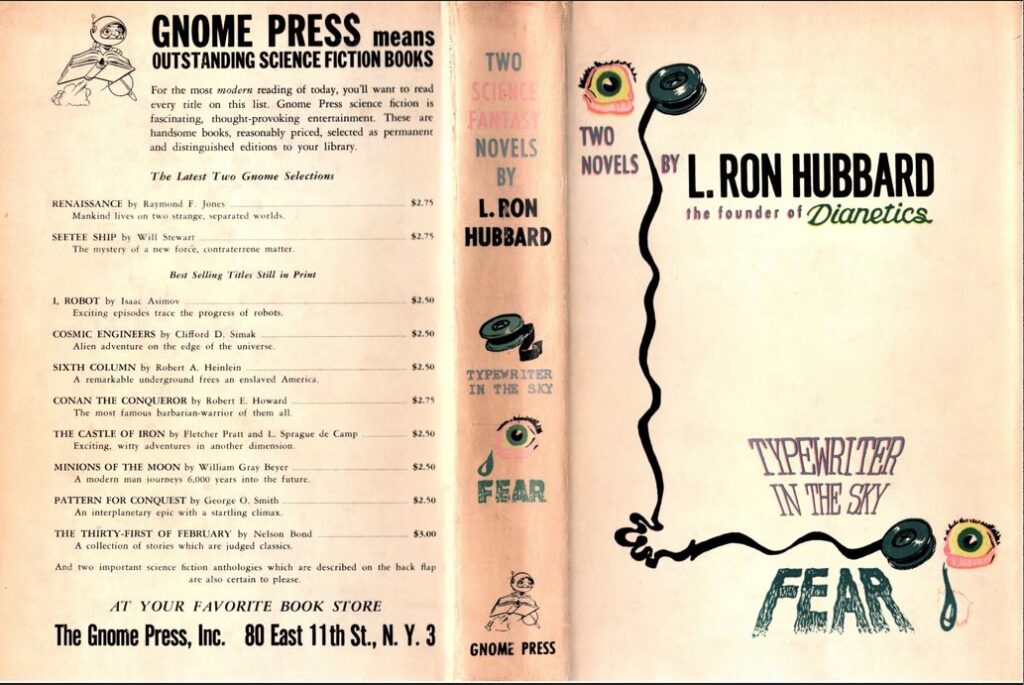Comments
Once again, the tininess and interconnectedness of the science fiction subculture is revealed in by an amazing anecdote. Lafayette Ronald Hubbard (1911-1986) had his first short story published in George Washington University’s college paper, The Hatchet, where it was acquired in 1932 by Paul Linebarger, the literary editor, who would two decades later embark on a brilliant science-fictional career as Cordwainer Smith.
Hubbard’s story was not sf, nor were his next hundred or so, scattered among dozens of pulp magazines – and one western novel – from 1934 to 1938. John W. Campbell finally snagged him and Hubbard became one of Astounding and Unknown’s most prolific contributors, with more than thirty stories before the end of 1942 when the war whisked him away with so many others.
Hubbard flunked out of GWU but not before forming their Glider Club and embarking on a pirate treasure-hunting sailing trip to the Bahamas. That also failed but left him with an itch for travel and adventure along with a seemingly-inexhaustible reservoir of tall tales that he used to push his smoking typewriter to speeds of up to 100,000 words a month, or so he claimed. None of his stories should be accepted without outside verification. That he was fast is indisputable; he even invested in a rare and costly electric typewriter and was rumored to work on a continuous scroll of butcher paper. Alex Nevala-Lee wrote in his book Astounding, citing a Hubbard letter, that “He would leaf through a magazine before going to bed, come up with the plot in his sleep, and write it the next morning, mailing it out without bothering to read it again.” If this was anything close to reality, it serves notice to moderns wondering if the pulps really were as awful as contemporaries thought. Hubbard’s pace slowed a bit to only about a story a month after the war and then stopped cold in 1950. By that time, of course, he had turned his life over to Dianetics, the profitable pseudoscience that caught so many other science fiction writers in its dazzling word salad.
Both stories in this collection originally ran in John Campbell’s Unknown Fantasy Fiction. Will Hubbard’s article “The Unknown Unknown,” printed in Earl Terry Kemps eI45 (August 2009), was compiled from previously unreleased payment files from the publisher, Street & Smith. He claims that Hubbard revised the story from an earlier piece, Robert P. Toombs’ “Prisoners of the Brain.” Toombs is recorded as having published a few mystery stories in the late 1940s, but nothing else is available on him. Nor can this claim be confirmed elsewhere. Nevertheless, it was common for authors to borrow unsold stories and rework them. The tiny community often acted like a group mind.
Gnome notes
Greenberg, for once, had a bit of luck in not getting there first. Arkham House and FPCI had published four collections of Hubbard’s stories before Gnome. The delay meant that Hubbard had turned from a cult yarn-spinner to a nationally-known commodity. Dave Kyle’s cover deprecated the titles of the actual stories below the important set of words: “Two Novels by L. Ron Hubbard/the founder of Dianetics.” Dianetics, the ancestor of Scientology, landed on the world with the impact of an alien spaceship in 1950. Hubbard had been working closely with Campbell on the project and gave Astounding first dibs, so the world got introduced to the subject when an article, “Dianetics: The Evolution of a New Science,” saw print in the April 1950 issue. Heritage House, then a tinier press than Gnome, published it as a long book, Dianetics: The Modern Science of Mental Health, in May 1950, using the unexpected windfall from its bestseller status to triple the number of books it published each year, fortunately for SF. One of them, 1953’s Science Fiction Handbook by the ubiquitous L. Sprague de Camp, probably claims pride of place as the first major book about the modern science fiction field.
Any clear-headed small publisher would have trumpeted his author’s bestselling, much-talked about, sf-connected, and less-than-year-old title on his front cover, even if published by a different press. From today’s perspective there’s a sense that Dianetics was all that mattered, that Hubbard was a forgotten pre-war pulpster whose name meant little to readers. Not quite true. Editors missed him greatly when he left for full-time Dianeticizing after 1950.
The dust jacket cover reads Two Novels by L. Ron Hubbard, with Typewriter in the Sky and Fear separated by a typewriter ribbon. The jacket spine says Two Science Fantasy Novels by L. Ron Hubbard, followed by a typewriter ribbon spool, the words Typewriter in the Sky, an eyeball with teardrop, and the word Fear. The board’s spine merely puts a stylized Typewriter in the Sky over Fear with no punctuation or graphics. The half title page reads Typewriter in the Sky and Fear. The title page, however, puts Typewriter in the Sky over Fear with a squiggly dingbat between. Later back panels would alternate between Typewriter in the Sky and Fear and Typewriter in the Sky & Fear. Not surprisingly, every bibliographer records the title in slightly different ways, as shown in this listing from the ISFDB:
Only Contento1 has the “and” in the title.
Clute/Nicholls lists the title as “Typewriter in the Sky/Fear“.
Clute/Grant lists the title as “Typewriter in the Sky; Fear“.
Tuck lists the title as “Fear & Typewriter in the Sky“.
Reginald1 lists title as “Two Science Fantasy Novels by L. Ron Hubbard, Typewriter in the Sky; Fear“.
Bleiler The Guide to Supernatural Fiction lists title as “Typewriter in the Sky Fear Two Science Fantasy Novels“.
The variants don’t stop there. The Catalog of Copyright Entries reads “Typewriter in the Sky. Fear. Two Novels.” CHALKER and KEMP both have Typewriter in the Sky & Fear. CURREY agrees with Clute/Nicholls.
Gnome issued one other double-titled volume, Lewis Padgett’s Tomorrow and Tomorrow and The Fairy Chessmen. For consistency, I’m using Typewriter in the Sky and Fear, which at least has provenance in actual Gnome usage.
ESHBACH lists a print run of 4,000 copies. CHALKER, however, has a twist:
Kyle and many dealers have a higher 6500 figure. We suspect but have not been able to confirm that 6500 was the print run, but that there were two bindings, the first in brown binding with decoration [two spools of typewriter ribbon], probably 4000 copies, the second c.1956 of 2500 in yellow boards which was heavily remaindered.
CURREY does not list a second binding. (He does, however, spell Hubbard’s first name as “La Fayette,” a styling I can’t find supported anywhere else.) No second binding has ever appeared in listings, to my knowledge. Back panels only list Typewriter until 1953, never to return, which would seem to defeat the point of a second binding. Moreover, the books before and after it, Renaissance and Seetee Ship, also disappear at the same time and there is no reason to think that these were anything but run-of-the-mill releases not worthy of special attention.
The confusion may stem from the unusual color used for the boards. Note that CHALKER talks about a brown binding. I’ve seen listings that put it as peach, tan, and fawn, which is a light yellowish tan. Yet my copy is better described as a sort of light orange cloth, and so are every set of boards I’ve seen online. A second binding of boards with a distinctly different color and the lack of the spools decoration would be a prize. The lack of any mention on back panels or in catalogs after 1953 makes a later set of boards highly unlikely, unfortunately.
Kirkus Reviews gave the expected publication date as April 15, 1951.
Reviews
Groff Conklin, Galaxy Science Fiction, September 1951
Typewriter in the Sky is a silly idea inexpertly carried out. … Fear, on the other hand, and despite its screwy modus operandi turns out to be a totally unexpected masterpiece of horror.
Groff Conklin, Galaxy Science Fiction, September 1951
Typewriter in the Sky is a silly idea inexpertly carried out. … Fear, on the other hand, and despite its screwy modus operandi turns out to be a totally unexpected masterpiece of horror.
Contents and original publication
• “Typewriter in the Sky” (Unknown Fantasy Fiction, November and December 1940).
• “Author’s Note” and “Fear” (Unknown Fantasy Fiction, July 1940).
Bibliographic information
Typewriter in the Sky and Fear, by L. Ron Hubbard, 1951, copyright registration date 15May51, Library of Congress catalog card no. none given [51-3763], title #14, back panel #146, 256 pages, $2.75. 4000 copies printed. Hardback, light orange cloth with spine lettered in black. Jacket design by David Kyle. “FIRST EDITION” stated on copyright page. Printed in the United States of America by the Colonial Press, Inc., and designed by David Kyle. Title page, jacket and copyright registration add “Two Novels.” Back panel: 10 titles. Gnome Press address given as 80 East 11th St., N.Y. 3.
Variants
None known.
Images





